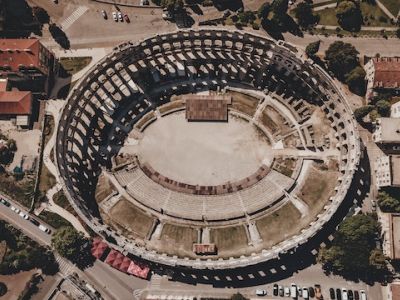Historic and religious structures in Montenegro hold profound significance as both cultural treasures and spiritual landmarks. They are living testaments to the nation’s rich history and the enduring legacy of its faith.
These structures, from the medieval monasteries like Ostrog and Reževići to the intricate frescoes of old churches, not only showcase remarkable architectural craftsmanship but also narrate the story of Montenegro’s spiritual journey through the centuries. They serve as places of worship, reflection, and pilgrimage for the faithful, offering solace and a connection to their heritage.
Moreover, these structures are cultural touchstones, reflecting the influence of various civilizations, from the Byzantine and Ottoman to the Venetian and Austro-Hungarian empires. Montenegro’s religious and historical sites are gateways to understanding its multicultural past and the coexistence of different traditions and influences. Visitors and travelers are drawn to their beauty, serenity, and the opportunity to immerse themselves in Montenegro’s cultural tapestry. These historic and religious structures are not just bricks and stones; they are the heart and soul of Montenegro, preserving its traditions, history, and the profound beauty of its spirituality for generations to come.
Montenegro, with its stunning landscapes and rich history, is home to several unique and captivating structures. Here are ten of them:
Table of Contents
Ostrog Monastery

Ostrog Monastery, perched high in the cliffs of Ostroška Greda in Montenegro, is a breathtaking marvel of both architectural and spiritual significance. Founded in the 17th century, this Serbian Orthodox monastery is dedicated to Saint Basil of Ostrog, one of the most revered saints in the Balkans. What makes Ostrog truly remarkable is its unique location, seemingly emerging from the sheer rock face of the mountain. The complex consists of two main cave churches, the Upper Monastery and the Lower Monastery, each adorned with magnificent frescoes and icons.
Pilgrims from all over the world journey to Ostrog to seek solace, healing, and spiritual enlightenment. The serene atmosphere and the backdrop of rugged cliffs create a sense of divine connection. One of the highlights of a visit is the tomb of Saint Basil, located in the Upper Monastery, where believers and curious travelers come to pay their respects and seek blessings.
Ostrog Monastery stands not only as a symbol of Montenegro’s deep religious heritage but also as an architectural wonder that defies gravity. Its significance extends beyond its physical beauty, as it represents a place where the spiritual and the earthly converge. Visiting Ostrog is a profound experience that offers a glimpse into the rich cultural and religious tapestry of Montenegro and the enduring power of faith in this enchanting Balkan nation.
Kotor Old Town Walls

The Kotor Old Town Walls are a testament to the historical significance and enduring beauty of this coastal town in Montenegro. These well-preserved medieval fortifications are a UNESCO World Heritage Site and form an integral part of Kotor’s identity. Stretching for over 2 miles and encompassing the entire old town, the walls ascend the steep slopes of the surrounding mountains, offering breathtaking panoramic views of the Bay of Kotor.
What sets the Kotor Old Town Walls apart is their remarkable construction, which combines defensive features like bastions and gates with a stunning architectural aesthetic. Visitors can explore the intricate system of forts, towers, and walls, including the iconic Sea Gate, Kampana Tower, and the Fortress of St. John, which crowns the hill above the town.
Walking along these ancient walls is a journey through time, as they have witnessed centuries of history, from the Venetian rule to the Ottoman Empire and beyond. The views from the walls are nothing short of spectacular, with the bay and the surrounding mountains providing a dramatic backdrop. For travelers, the Kotor Old Town Walls offer a chance to immerse themselves in history, culture, and natural beauty all at once, making them an essential experience in this charming Montenegrin town.
Tara Bridge

The Tara Bridge, an engineering masterpiece situated in the heart of Montenegro, is a testament to human ingenuity and a tribute to the country’s stunning natural landscapes. Spanning the Tara River Canyon, the second deepest canyon in the world after the Grand Canyon, this concrete arch bridge is a marvel of both form and function. Built between 1937 and 1940, it stands at a height of 564 feet (172 meters) above the Tara River, offering not only a vital transportation link but also a breathtaking vista of the rugged terrain below.
The Tara Bridge is renowned for its sleek design and harmonious integration with the surrounding environment. Its clean lines and graceful arches contrast strikingly with the wild beauty of the canyon. It’s not only an engineering marvel but also an ideal spot for adrenaline junkies who engage in bungee jumping, offering one of the world’s most thrilling jumps.
Moreover, the bridge plays a crucial role in connecting the northern and southern regions of Montenegro, facilitating trade and travel. Its scenic location in Durmitor National Park, a UNESCO World Heritage Site, makes it a perfect entry point for exploring this pristine wilderness.
The Tara Bridge, with its blend of engineering excellence and natural splendor, is a symbol of Montenegro’s commitment to preserving its heritage and enhancing its accessibility while respecting the awe-inspiring beauty of its natural landscapes. It’s not just a bridge but a gateway to adventure and a testament to the harmonious coexistence of human achievement and the grandeur of nature.
Lady of the Rocks

Our Lady of the Rocks, or “Gospa od Škrpjela” in Montenegrin, is a captivating man-made islet located in the Bay of Kotor, Montenegro. This unique and picturesque site holds deep cultural and religious significance. According to legend, the islet was created by local fishermen who, over centuries, sank old ships loaded with stones and scuttled their vessels in this spot as a form of reverence for the Virgin Mary, whom they believed protected them at sea.
The centerpiece of Our Lady of the Rocks is the Church of Our Lady of the Rocks, a small, charming chapel that was built atop the islet and is adorned with a wealth of artwork, including a stunning collection of 68 paintings by the famous Baroque artist Tripo Kokolja. One of the most remarkable aspects of the church is its intricately decorated interior, featuring a richly adorned altar and a magnificent iconostasis.
Every year on July 22nd, locals from the nearby town of Perast participate in a traditional event known as the “Fasinada,” where boats filled with stones are added to the islet’s foundations. This annual celebration is both a tribute to the legend and a vibrant expression of Montenegro’s cultural heritage.
Our Lady of the Rocks stands not only as a testament to the region’s unique traditions but also as a symbol of faith, artistry, and the enduring connection between Montenegro and the sea. The islet’s tranquil setting, steeped in history and surrounded by the dramatic beauty of the bay, continues to captivate visitors from around the world.
Durmitor National Park

While not a single structure, the dramatic landscapes and unique geological formations within this national park, including the Black Lake, are exceptional. Durmitor National Park, nestled in the rugged terrain of northern Montenegro, is a UNESCO World Heritage Site and one of Europe’s most breathtaking wilderness areas. This natural wonderland encompasses the Durmitor Massif, a dramatic limestone mountain range adorned with numerous peaks, deep canyons, pristine glacial lakes, and dense forests. One of its most famous features is the Tara River Canyon, the second deepest canyon in the world after the Grand Canyon, which offers exhilarating white-water rafting opportunities.
The park’s diverse ecosystems support a wealth of flora and fauna, making it a haven for nature enthusiasts and ecologists. It’s home to over 1300 plant species and a variety of wildlife, including brown bears, wolves, chamois, and eagles.
Durmitor is also a paradise for outdoor adventurers. In the winter, its snow-covered slopes transform into a skiing and snowboarding destination. In the warmer months, hikers, climbers, and cyclists explore its numerous trails and peaks.
The pristine Black Lake, nestled within the park, is one of its iconic attractions, surrounded by lush greenery and reflections of Durmitor’s peaks on its surface. The park’s combination of natural beauty and outdoor activities makes it a magnet for travelers seeking both adventure and serenity in the heart of Montenegro. Whether you’re an adrenaline junkie or a nature lover, Durmitor National Park promises an unforgettable experience in one of Europe’s most untouched and awe-inspiring landscapes.
Sveti Stefan

Sveti Stefan, often referred to as “Montenegro’s Jewel,” is a picturesque island village located on the Adriatic coast of Montenegro. This stunning destination is renowned for its breathtaking beauty and unique charm. The village is perched on a small, rocky island connected to the mainland by a narrow causeway, creating a postcard-perfect scene that has attracted travelers and celebrities alike.
Originally a fishing village dating back to the 15th century, Sveti Stefan was transformed into an exclusive luxury resort in the 1960s. Today, the island is home to a collection of meticulously restored stone buildings, now serving as guest accommodations for the high-end resort. The narrow, winding streets are lined with charming shops, cafes, and boutiques, making it a delightful place to explore.
The pink sandy beaches surrounding Sveti Stefan are some of the most beautiful on the Adriatic coast, and the clear turquoise waters are perfect for swimming and snorkeling. The island’s historical and architectural significance, combined with its natural beauty, has earned it the nickname “A Pearl of the Adriatic.”
Sveti Stefan’s allure lies in its ability to transport visitors to a bygone era while providing modern luxury and comfort. It’s a place where history, culture, and natural beauty seamlessly blend, making it a must-visit destination for those seeking a taste of the Adriatic’s elegance and charm.
Podgorica Millennium Bridge

The Podgorica Millennium Bridge, an iconic structure spanning the Morača River in Montenegro’s capital city, is a testament to modern engineering and architectural innovation. This cable-stayed bridge, completed in 2005 to commemorate the city’s 2,000th anniversary, is a symbol of Podgorica’s transformation into a contemporary European capital.
The most distinctive feature of the Millennium Bridge is its elegant, asymmetrical design. A single pylon rises dramatically from the riverbed, supporting a series of cables that fan out to hold the bridge deck in place. This creates a striking visual contrast with the surrounding cityscape. At night, the bridge is illuminated, casting a radiant glow that reflects on the river below and adds to its allure.
The bridge serves as a vital transportation link, connecting the city’s two banks and facilitating the flow of traffic and pedestrians. It has become an essential part of Podgorica’s urban fabric and a symbol of progress. The Millennium Bridge also provides picturesque views of the city and the Morača River, making it a popular spot for both locals and visitors.
Beyond its functional purpose, the Podgorica Millennium Bridge stands as an architectural marvel, representing Montenegro’s embrace of modernity while preserving the natural beauty of its surroundings. It has become an emblem of the city’s development and an essential landmark in the dynamic and evolving capital of Montenegro.
Ostrvo Sveti Nikola

Ostrvo Sveti Nikola, or St. Nicholas’ Island, is a captivating islet located in the vicinity of the famous Sveti Stefan island resort on the Montenegrin coast. This charming and scenic island complements the grandeur of its larger neighbor and adds to the allure of the entire area.
St. Nicholas’ Island is notable for its pristine natural beauty and its iconic pink sandy beaches, which are characteristic of this part of the Adriatic coast. The island remains relatively untouched, with lush Mediterranean vegetation covering its terrain. Its small size and peaceful ambiance make it a perfect escape for travelers seeking tranquility and solitude.
The island’s picturesque chapel, dedicated to St. Nicholas, is a prominent feature and serves as a reminder of its spiritual heritage. Visitors often take leisurely walks around the island, enjoying the unspoiled landscapes and breathtaking views of the surrounding azure waters.
While the island itself is not accessible for overnight stays, its proximity to the luxurious Sveti Stefan resort means that guests can enjoy its natural beauty and serene atmosphere as part of their stay. Whether you’re basking in the sun on its pristine beaches, exploring its charming chapel, or simply admiring the island from afar, Ostrvo Sveti Nikola adds a touch of natural wonder to the already enchanting coastline of Montenegro.
Piva Monastery

The Piva Monastery, known locally as Manastir Piva, is a serene and spiritually significant Orthodox monastery nestled in the remote and pristine Piva River Canyon in Montenegro. Established in the 16th century, this monastery has endured centuries of history, including periods of Ottoman rule and the challenges of war, maintaining its place as a spiritual and cultural gem.
What makes Piva Monastery truly captivating is its striking architectural beauty and its location on the shores of the Piva Lake, formed by a dam on the Piva River. The monastery complex features a series of stone buildings with distinct red roofs and elegant white facades, surrounded by lush greenery and the tranquil waters of the lake. The Church of the Assumption of the Virgin Mary, the centerpiece of the complex, is adorned with intricate frescoes and religious icons, providing a glimpse into the spiritual and artistic heritage of Montenegro.
Piva Monastery is not only a place of worship and spiritual reflection but also a testament to the resilience of faith and culture in the face of adversity. The surrounding natural beauty, with the rugged canyons and pristine lake, adds to its charm and provides a peaceful backdrop for visitors. The monastery is accessible via a scenic drive through the canyon, making it an ideal stop for travelers seeking a combination of cultural enrichment and immersion in Montenegro’s unspoiled landscapes.
Stanjevići Monastery

The Stanjevići Monastery, nestled in the verdant hills of Montenegro, is a serene and historically significant Orthodox monastery that has endured for centuries. Founded in the 12th century, it stands as a testament to Montenegro’s deep spiritual and cultural heritage. The monastery complex features a charming stone church dedicated to the Holy Trinity, adorned with intricate frescoes that showcase the artistic and religious legacy of the region.
What sets the Stanjevići Monastery apart is its idyllic location amidst the pristine nature of Montenegro. Surrounded by lush forests and with a backdrop of rugged mountains, the monastery offers a tranquil and reflective atmosphere for visitors. The natural beauty of the area enhances the sense of peace and spirituality, making it a perfect retreat for those seeking both cultural enrichment and a connection with the unspoiled landscapes of Montenegro.
The Stanjevići Monastery is not only a place of worship but also a symbol of resilience and cultural preservation. Its historical and architectural significance, combined with its serene surroundings, make it a place of spiritual reflection and appreciation of Montenegro’s rich heritage. Visitors can explore the monastery grounds, admire the frescoes, and take in the breathtaking views of the surrounding countryside, making it a memorable stop on any journey through Montenegro.
These unique structures, each with its own story and significance, contribute to Montenegro’s cultural and natural diversity, making it a fascinating destination for travelers and history enthusiasts.
Montenegro’s historic and religious structures stand as timeless testaments to the country’s rich cultural heritage and spiritual significance. These architectural marvels, often nestled in stunning natural landscapes, hold a unique blend of historical, artistic, and religious importance. They not only showcase Montenegro’s long and diverse history, from medieval monasteries to Ottoman-era mosques, but also display the enduring faith and cultural traditions of its people.
The beauty of these structures lies not only in their architectural splendor but also in their harmonious integration with the surrounding environment. Many Montenegrin monasteries and churches are adorned with intricate frescoes and religious art, offering glimpses into centuries-old traditions and craftsmanship.
Beyond their cultural and artistic significance, these religious sites often offer tranquil and contemplative spaces amidst Montenegro’s breathtaking natural beauty, from the serene shores of Lake Skadar to the dramatic landscapes of Durmitor National Park. Whether you’re exploring the historic streets of Kotor, admiring the frescoes of Ostrog Monastery, or meditating in the peaceful courtyards of Plavnica Monastery, these structures serve as bridges between the past and the present, inviting travelers to connect with the spiritual, historical, and natural wonders of Montenegro.


















We stumbled over here by a different website and thought I may as well check things out. I like what I see so now i am following you. Look forward to exploring your web page yet again.